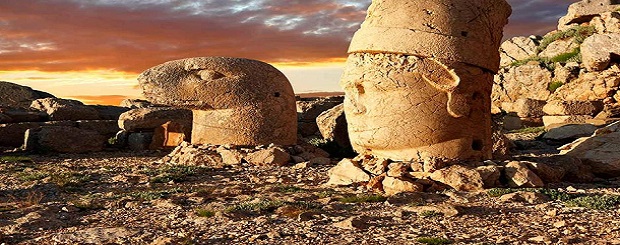
Art-A-Tsolum – Tomb Of The Armenian King On Mount Nemrut
July 17, 2023 / Antiquities / Art-A-Tsolum – PREVIOUS ARTICLE:

Mount Nemrut, holds a significant place in the rich tapestry of Armenian history. At its peak, rests the ancient tomb of King Antiochus I Yervanduni, a vestige of the Kingdom of Commagene’s glorious past, an Armenian kingdom that thrived during the Hellenistic period from the 4th to 1st century BC.
King Antiochus I Yervanduni, from the Yervandid dynasty, ruled the Kingdom of Commagene from 70 to 38 BC. His 32-year reign is remembered for his profound impact on the architectural landscape of the kingdom. His legacy is immortalized in the form of the tomb that he commanded to be built in 62 BC on Mount Nemrut, standing at an impressive elevation of 2150 meters above sea level.
The sanctuary of Mount Nemrut comprises more than just the king’s tomb. It is a complex array of structures, including colossal statues erected around the burial place. These statues, each a piece of artistic marvel, only amplify the mystic allure of the place, making it a visual treat.
The construction of this ritual complex was closely linked to Antiochus I’s belief in his divine origin. He insisted his subjects refer to him as a “god” and envisioned Mount Nemrut as a grand religious center that would encapsulate his divine status.
Plans for the complex included a temple dedicated to Antiochus I, surrounded by statues of the Commagene gods. Most of these statues, which have since been reduced to stone heads, were installed. However, the construction of the temple dedicated to the king was never completed. Upon the king’s death, work on the site came to a standstill. The statues that were already installed, though partially destroyed due to earthquakes, still stand as a testament to Antiochus I’s ambitious vision and his significant impact on the region’s architecture.
In recognition of its historical and cultural importance, the archaeological sites of Mount Nemrut, including the tomb and the statues, were added to the UNESCO World Heritage List in 1987. Today, it continues to attract history enthusiasts, archaeologists, and tourists, who are captivated by the enigmatic charm of the place and the stories it continues to tell of a king who saw himself as a god and the mighty kingdom he once ruled.
Vigen Avetisyan
allinnet.info/antiquities/tomb-of-the-armenian-king-on-mount-nemrut/
